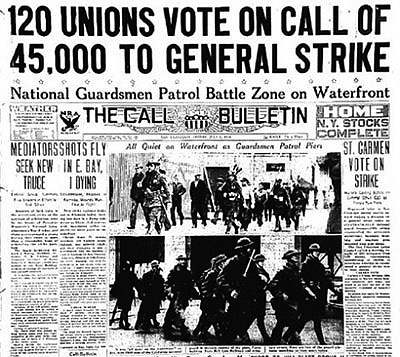
At 8 a.m. on Monday, July 16, 1934, San Francisco General Strike officially began, involving around 150,000 workers around the Bay. Workers from all industries walked off the job, in response to a call by longshore workers for a general strike. The call was supported by the San Francisco Labor Council.
The strikes had already been rolling along for a few days: between July 11 and 14, over 30,000 workers went out on strike, including teamsters, butchers, laundry workers, and more; by July 12, 21 unions had voted to strike, most of them unanimously.
It came after the brutal “Bloody Thursday” of July 5, in which 5,000 workers fought 1,000 police, scabs, and National Guard troops as employers tried to break a San Francisco longshore strike. Two strikers were killed, and 109 people were injured. On July 9 more than 40,000 strikers and their supporters marched down San Francisco’s Market Street behind a flatbed truck carrying the coffins of Nick Sperry and Howard Bordoise.
The key issue was the longshore workers’ demand for union control instead of employer control of hiring halls, the galling mandatory membership in the hated “Blue Book Union,” established after the ship owners had busted the San Francisco local of the International Longshoremen’s Association (ILA) in 1916.
The ship owners’ association had established the “shape up” hiring hall-where it took a bottle of whiskey or a dollar bill to secure a job-as a way to break union power. The employer-controlled system’s abuses included under-employment, low earnings for many, long and fruitless waits at the docks, favoritism for corrupt gangs, and petty graft as the price of jobs.
For the first time in American labor history, craft jealousies were broken down as skilled and unskilled personnel cooperated on an equal basis. And for one of the first times in history, the rank-and-file was in full control of a major strike.
Harry Bridges’ role in leading the maritime workers to victory in the historic 1934 strike was only the beginning of the impact he had on American unions and the fight for democracy.
Early in the strike, Bridges insisted and convinced the strikers that full equality for Black longshoremen was a necessary part of a victory strategy. He went to Black churches in the Bay Area and urged congregations to join strikers on the picket line, saying that when the strike was won, Blacks would work on every dock on the West Coast. He kept his promise. This opened the door for the ILWU to become one of the most integrated, multiracial and multinational unions in the country.
The strike ended on July 31 when the unions agreed to binding arbitration. When the arbitration board handed down its award on October 12, longshore workers had their hiring hall, a closed shop, the 30-hour week, higher wages, union recognition and a coast-wide contract – substantially every demand they had made in February.
For more detailed coverage of the struggles to organize the ILWU and the life and contributions of organizer Harry Bridges, read: Harry Bridges and the ILWU From Wharf Rats to Lords of the Docks.
Photo: Today in Labor History.









Comments